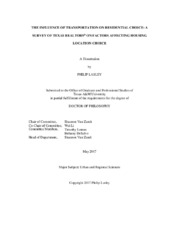| dc.description.abstract | Why do people choose to live where they do? Answers to this simple yet intricate question can provide insight into how important transportation issues are to the housing location choice among other factors and how transportation policies and priorities could be modified to improve the type, scale, and timeliness of transportation and other civil improvements—improving the efficiency of public money spent on transportation. This research will survey REALTORS® in Texas about their last transaction to identify what factors may have influenced their client’s decision to choose a particular region, neighborhood, and house. The responses will show what factors were important to their client, how important each individual factor was, and how these factors rank compared to one another at each of the three focus levels: choosing the region, choosing the neighborhood, and choosing the specific home.
Results were tabulated for all of Texas; the Austin, Dallas-Fort Worth, Houston, San Antonio, and Corpus Christi metropolitan areas; and rural and smaller urban areas. The survey results revealed that decisions are overwhelmingly driven by attributes of the house itself, with price being the most important factor in most cases. Neighborhood quality—amenities, reputation, and aesthetic—generally ranked second. Although traffic and transportation concerns are important (especially to millennials, singles, and those with no kids), these factors rank near the middle. Respondents commented that while traffic concerns may have played an important initial role, other factors overtook them as the search progressed. Traffic does not appear to deter people from moving to a new city, but bad traffic and long travel times do appear to deter buyers from certain neighborhoods if other, more important factors are first accommodated. This finding suggests more-accessible neighborhoods by any transportation mode are more desirable to buyers.
These results for each urban area could be used by policy makers to better meet the needs of home buyers and attract them to locations with excess transportation capacity, thereby creating synergistic benefits to both transportation and other civil services. | en |


